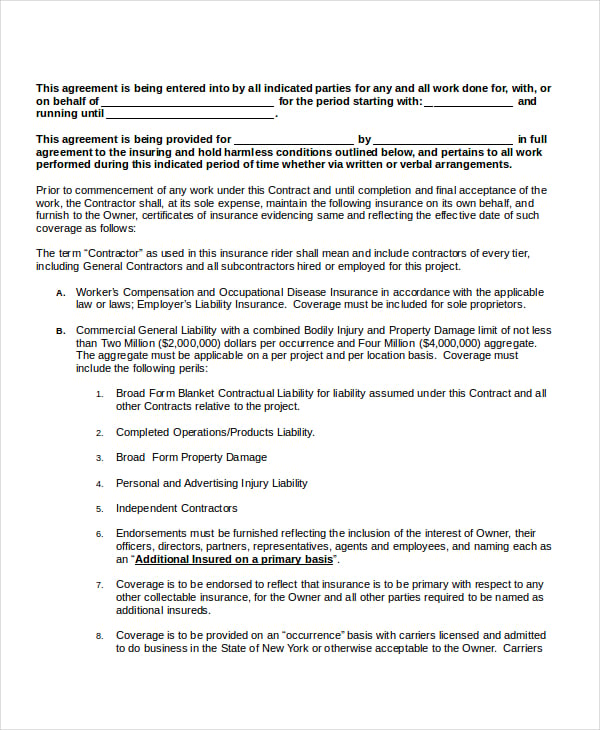Insurance Made Simple. Trusted by Thousands of Businesses Nationwide. Protect Your Expertise. Mutual Indemnification.
If and to the extent that the indemnified party has insurance coverage, or the right to make claim against any third party for any amount to be. Sometimes mutual indemnification is needed , but a good understanding and precise scope of responsibility need to be drafted so legal counselors can address the situation. Is a mutual indemnity clause beneficial? Why is an indemnification clause important?
What is an indemnification clause? At the end of the day, a mutual indemnification clause will simply mean that each party is accepting risk for its own conduct – a principal both parties can typically support. Their purpose is to transfer the risk of certain losses or expenses on construction projects from the GC to the subcontractor.

Usually (but not always), the losses or expenses which trigger the subcontractor’s duty to indemnify are those involving bodily injury or property damage. Such clauses can be constructed so that only one party is indemnified by the other or mutual indemnification occurs. Hold harmless and indemnification agreements also need to be included in the subcontract agreement. They add another layer of protection for your company by ensuring that the subcontractor is responsible for the costs of any potential loss or legal action incurred. Indemnification clauses in residential construction contracts requiring subcontractor to indemnify the general contractor for the contractor’s negligence (whether active, passive, or intentional) are void and unenforceable as against public policy.
With one-way indemnification, only one party is indemnifie meaning only their losses would be covered. Avoid Errors In Your Indemnity Agreement. Get Coverage Instantly from biBERK. Over 1M Forms Created - Try 1 Free!
Compensation and How We Can. Simply put, the court concluded that indemnity language contained in the pre-printed subcontracts did not evidence a mutual understanding of the parties that the subcontractor would indemnify the developer even if its work was not negligent. Moreover, there is nothing in MGL 1§ 29C that specifically prohibits a proportionate.
The supplier agrees to indemnify and hold harmless the customer against all claims arising in respect of any injury, death, sickness or ill-health caused to or suffered by the customer and its personnel as a result of performance or non-performance of this Agreement. The provisions of a hold harmless agreement minimize the risk of being part of a litigation or allow you to pursue a claim for indemnity if a subcontractor or any of. It is critical to note that indemnity agreements are not insurance agreements.

Indemnity agreements operate merely as risk transfer devices transferring liability from one party to another. With that sai indemnity and insurance agreements often go hand-in-hand. The subcontract indemnity provision was a Type III, which called for indemnity for liabilities “on account of, or related to, any act or omission … of the Subcontractor. Active negligence on the part of the general contractor would ordinarily bar recovery under such a clause. Boilerplate Subcontractor Contract One of the issues you face as a manufacturer or contractor is the misdeeds of any subcontractor that you may hire.
Most STICO insureds require certificates of insurance from their subcontractors to prove that they have insurance in place. The contractor is generally required to indemnify the owner, the subcontractor is then expected to indemnify the contractor and usually the owner, and even the sub- subcontractor may be asked to hold parties harmless. D for mutual indemnification for damages arising out of negligence, and specifically limits the indemnification to the percentage share of the indemnifying party’s negligence. Percentage Share of Negligence.
Union Pacific Railroad Corp. United States, Fed. Berkshire Hathaway Company. Job-Related Accidents or Illness.
Should they sign these conditions, there are a couple of potential policy restrictions to watch out for. Indemnity clauses are usually imposed on the one participant in a contract who has the smallest share of bargaining strength. In construction contracts, it is common for a contractor to be required to indemnify the owner, and sometimes even the architect, against claims and liability.
As a subcontractor , you would indemnify the GC or owner to the extent of your fault, provided that those parties also agreed to indemnify you to the. Contractor also shall require any of its subcontractors to maintain adequate insurance. Note: Your local attorney and insurance agent can provide guidance about insurance requirements and appropriate limits.
One area that often creeps into the indemnity language is where direct claims between the parties become subject to indemnification. As noted above, this is a common approach in MA transactions for post-closing claims, but in the context of commercial contracts establishing an ongoing relationship between the parties, it arguably is not helpful. The best way to secure your business with someone is by making them sign a hold harmless agreement.
A hold harmless agreement makes sure that the person you are doing business with, does not take any legal action against you in case the business doesn’t go as planned. Find Legal Indemnification. Get High Level of Information!
Search for Legal Indemnification.
No comments:
Post a Comment
Note: Only a member of this blog may post a comment.